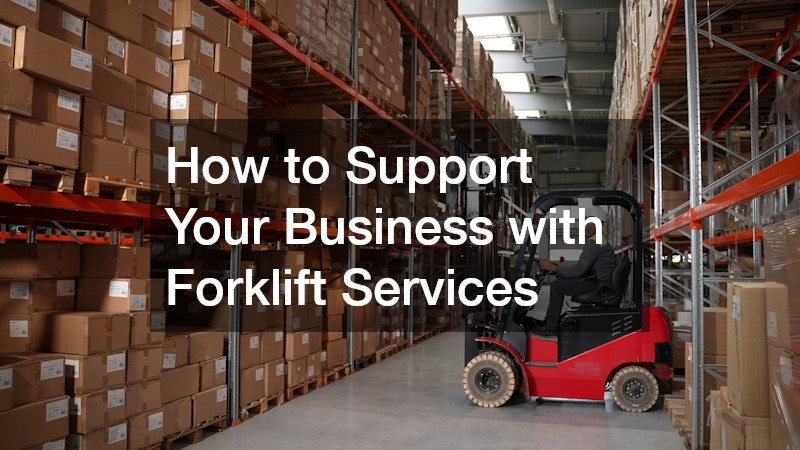Understanding how forklift services can enhance business operations is essential for companies involved in heavy lifting and logistics. This article explores the key aspects of supporting your business with these indispensable services. From improving warehouse efficiency to ensuring safer material handling, forklifts are vital in streamlining day-to-day operations.
What are the Benefits of Using Forklift Services?
Integrating forklift services into your business can significantly improve productivity and efficiency, allowing for smoother and more effective operations. Forklifts are designed to handle tasks ranging from transporting heavy materials to loading and unloading goods, which can drastically reduce the time needed for such operations. Consequently, businesses can streamline their workflow, reduce manual labor, and focus on core activities that drive growth.
Moreover, forklifts equipped with the latest technology, such as GPS tracking and advanced safety features, can further enhance operational efficiency. These innovations allow operators to maneuver equipment with greater precision, reducing the risk of accidents while increasing the speed of operations. Additionally, the adaptability of forklifts to various industrial environments, whether in warehouses or construction sites, ensures that businesses can maintain consistent productivity across different terrains.
Forklifts also play a pivotal role in optimizing space utilization by efficiently stacking and retrieving goods in warehouse settings. This optimized space management increases available storage and enables businesses to manage inventory more effectively. Enhancing operational efficiency through reliable equipment, such as forklifts, in a competitive market can give businesses a crucial advantage.
How to Choose the Right Forklift for Your Needs?
Choosing the right forklift involves carefully evaluating your business needs, including load capacity, terrain, and lifting height, to ensure optimal performance. Each business has unique operational demands; some may require forklifts to handle extremely heavy loads, while others need equipment for maneuvering tight spaces. It is crucial to analyze these needs to select the appropriate forklift model that meets operational demands without compromising safety or efficiency.
Consideration should also be given to the environment where the forklift will operate. For instance, electric forklifts are more suitable for indoor use due to zero emissions, while diesel or gas-powered models perform better in outdoor or rugged terrain conditions. Assessing these environmental factors can help select a forklift that is not only efficient but also environmentally friendly and cost-effective in the long run.
Furthermore, evaluating additional features such as ergonomic design, which reduces operator fatigue, and technological integrations that provide operational data, can significantly influence the selection process. Investing time in understanding these parameters ensures that the chosen forklift will enhance productivity and contribute positively to the organization’s logistics and material handling processes.
What is the Cost Involved in Forklift Services?
Explore the various factors contributing to the cost of forklift services, such as rental versus purchase, maintenance expenses, and operator training. Renting a forklift can be a cost-effective solution for businesses with short-term projects, while purchasing may be beneficial for long-term operational needs. The decision between renting and purchasing hinges on the business’s financial capabilities and strategic objectives.
Maintenance expenses are another crucial factor to consider, as regular upkeep ensures the longevity and reliability of the equipment. Investing in preventive maintenance can mitigate unexpected repair costs and minimize downtime, which can otherwise disrupt operations and lead to revenue losses. Ensuring that forklifts are well-maintained reduces long-term costs and enhances safety and operational efficiency.
Additionally, the operator training cost should be factored into the total investment in forklift services. Properly trained operators can maximize efficiency and safety, reducing the risk of accidents and improving equipment handling. Engaging certified trainers and implementing comprehensive training programs is an investment that yields high returns by enhancing operational safety and productivity.
How to Maintain Safety Standards with Forklift Operations?

Learn about the safety measures and training programs necessary to ensure a secure and accident-free environment when using forklifts. Establishing rigorous safety protocols begins with comprehensive operator training that focuses on safe handling practices, emergency procedures, and hazard recognition. This foundational knowledge is crucial for minimizing risks and promoting a culture of safety within the workplace.
Implementing regular safety audits and inspections is another vital component of maintaining high safety standards. These evaluations help identify potential hazards and areas for improvement, ensuring that forklifts are always in optimal working condition. Integrating safety technologies, such as collision warning systems and automatic braking, can further enhance operator awareness and prevent accidents.
Creating a safety-oriented work environment involves continuous education and reinforcement of best practices. Encouraging open communication about safety concerns and promoting a team-based approach to risk management strengthens the overall safety culture. Businesses can protect their workforce and maintain operational integrity by prioritizing safety and consistently adhering to established protocols.
Incorporating forklift services into your business strategy can enhance productivity and safety, making it a pivotal part of handling materials and logistics effectively. By understanding the benefits, choosing the right equipment, managing costs, and maintaining safety standards, businesses can leverage forklift services for sustained growth and efficiency. In today’s competitive market, optimizing forklift operations can provide businesses with a significant edge, ensuring they meet operational demands and safety requirements.
